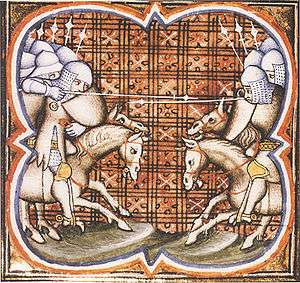Battle of Muret
| Battle of Muret | |||||||
|---|---|---|---|---|---|---|---|
| Part of the Albigensian Crusade | |||||||
 The Battle of Muret: illustration from the Grandes Chroniques de France | |||||||
| |||||||
| Belligerents | |||||||
|
|
| ||||||
| Commanders and leaders | |||||||
|
Simon IV de Montfort Bouchard de Marly Guillaume des Barres Guillaume de Contres |
Peter II of Aragon † Raymond VI, Count of Toulouse Raimond-Roger, Count of Foix | ||||||
| Strength | |||||||
|
900 cavalry 700 infantry |
2,200 cavalry 20,000–30,000 infantry | ||||||
| Casualties and losses | |||||||
| 8[1] | 15,000–20,000[2] | ||||||
At the Battle of Muret[3] on 12 September 1213 the Crusader army of Simon IV de Montfort defeated the Catharist, Aragonese and Catalan forces of Peter II of Aragon, at Muret near Toulouse.
Background
Simon IV de Montfort was the leader of the Albigensian Crusade to destroy the Cathar heresy and incidentally to join the Languedoc to the crown of France. He invaded Toulouse and exiled its count, Raymond VI. Count Raymond sought assistance from his brother-in-law, King Peter II of Aragon, who felt threatened by Montfort's conquests in Languedoc. He decided to cross the Pyrenees and deal with Montfort at Muret.
On 10 September, Peter's army arrived at Muret, and was joined by a Toulousain militia. He chose to position his army so their right flank was protected by the Saudrune River, and the left protected by a marsh. He left the Toulousain militia to assault the walls of the city.
Armies
Simon de Montfort led an army of 1,600 French Crusaders, along with a small contingent of knights brought by his ally, the viscount of Corbeil. Simon de Montfort's 900 cavalry included 270 knights, making the small Crusader force of exceptional quality. King Peter of Aragon had brought 800 to 1,000 Aragonese cavalry, joined by a militia from Toulouse and armies brought by the counts of Comminges and Foix. King Peter of Aragon's combined forces possibly numbered 4000 cavalry, with 30,000 to 40,000 infantry.
Battle
Montfort divided his army into three squadrons, and then led them across the Garonne to meet the Aragonese forces. Peter's ally and brother-in-law, Count Raymond, advised a defensive posture in order to weaken the advancing enemy with bowshot and javelins. Peter rejected this suggestion as unknightly and dishonorable. King Peter rode to the front line, forsaking his royal armour for the plain armour of a common soldier. His army was disorderly and confused. When Montfort's first squadron charged the field, the Aragonese cavalry was crushed and Peter himself was unhorsed. He cried out, "I am the king!" but was killed regardless. With the realization that their king had been killed, the Aragonese forces broke in panic and fled, pursued by Montfort's Crusaders.
Aftermath
Montfort then returned to the besieged Muret. The militia from Toulouse renewed their assault on the city. When they saw the Crusader horsemen returning and learned that King Peter of Aragon was killed[4] they broke and fled their fortified camp toward the Garonne River. They were slaughtered in the rout.[5] This would be the last major battle of the Albigensian crusade.[4]
Notes
- ↑ Paladilhe, Simon de Montfort et le drame cathare, p. 227.
- ↑ Peter of Vaux de Cernay, Historia Albigesis
- ↑ Also called Murel, Murell, or Morel.
- 1 2 A Global Chronology of Conflict: From the Ancient World to the Modern Middle East, Vol. I, ed. Spencer C. Tucker, (ABC-CLIO, 2010), 269.
- ↑ Marvin, Laurence The Occitan War: A Military and Political History of the Albigensian Crusade, 1209–1218, Berry College: Cambridge University Press, 2008, 175–195.
Sources
- (Spanish) Martín Alvira-Cabrer, El Jueves de Muret. 12 de Septiembre de 1213, Universitat de Barcelona, Barcelona, 2002. ISBN 84-477-0796-2
- (Spanish) Martín Alvira-Cabrer, Muret 1213. La batalla decisiva de la Cruzada contra los Cátaros, Ariel, Barcelona, 2008. ISBN 978-84-344-5255-8
- Jonathan Sumption. The Albigensian Crusade, 2000
- William of Puylaurens, Chronica, trans. W.A. Sibly and M.D. Sibly, 2003. §§ XX-XXI.
- Hoffman Nickerson, Warfare in the Roman Empire, the Dark and Middle Ages, to 1494 A.D., 1925
- Laurence Marvin, "The Occitan War: A Military and Political History of the Albigensian Crusade, 1209-1218", Berry College: Cambridge University Press, 2008, 175-195.